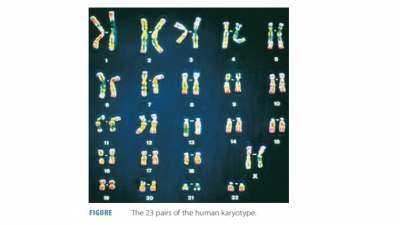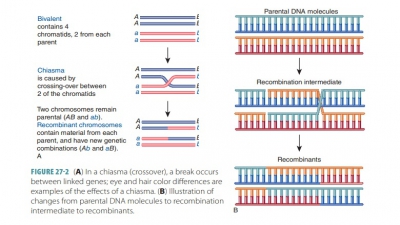Patterns of Inheritance
| Home | | Anatomy and Physiology | | Anatomy and Physiology Health Education (APHE) |Chapter: Anatomy and Physiology for Health Professionals: Heredity
Most human traits are based on multiple alleles or by interaction between several gene pairs.
Patterns
of Inheritance
Most human traits are based on multiple alleles or by
interaction between several gene pairs. A small num-ber of human phenotypes are
related to a single gene pair, yet most of these traits are extremely limited
in nature. They may also reflect variations in single enzymes.
Dominant-Recessive Inheritance
The interaction of dominant and recessive alleles is known
as dominant-recessive inheritance. By using
a diagram known as a Punnett
square, the pos-sible gene combinations in a single trait, which
would occur from the mating of parents of known genotypes, can be determined (FIGURE 27 -3). A dominant allele is written as a
capital “T,” while a recessive allele is written as a lowercase “t.” Therefore,
the possible combinations in offspring, based on the fact that each
heterozygous parent has the “Tt” genotype, is:
■■ Homozygous
dominant child (“TT”): 25% possibility
■■ Heterozygous child (“Tt” or “tT”):
50% possibility
■■ Homozygous recessive child (“tt”):
25% possibility
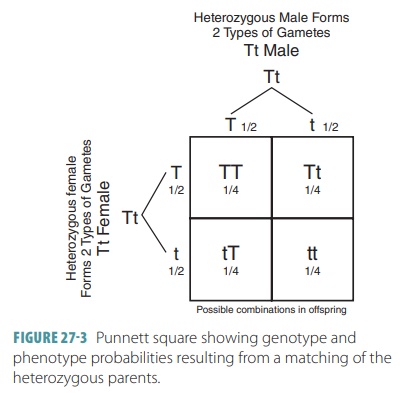
The Punnett square only predicts the probability of a
particular genotype and phenotype. When there are more offspring, the
likelihood that the ratios will conform to predicted values increases. Often,
parents of only two offspring will find that both of them are heterozygous
(“Tt”), since this possibility is of higher probability.
To understand the probability of two events hap-pening successively, it is necessary to multiply the probabilities of the separately occurring events. Each child’s development is an independent event that does not influence the development of any other offspring by the same child. The three major modes of inher-itance are autosomal recessive, autosomal dominant, and X-linked recessive.
Dominant Traits
An autosomal dominant
condition requires only one disease-causing allele for inheritance.
Exam-ples of dominant traits in humans include dimples, freckles, and the
development of a widow’s peak in the center of the hairline. There are few
disorders that are caused by dominant genes. This is because lethal dominant genes are usually expressed
and cause
the death of an embryo, fetus, or child. In cer-tain dominant disorders, the
individual may be less impaired and survived longer, even into his or her
reproductive years. An example of such a dominant disorder is Huntington’s disease, which fatally affects
the nervous system. The basal nuclei degen-erate because of a delayed action gene expressed by the
individual at about age 40. The offspring of a parent with this disease has a
50% chance of inherit-ing the lethal gene. The parent is heterozygous, since
the dominant homozygous condition would be lethal to the
fetus. With today’s advancements in genetics, many children of parents with
Huntington’s disease choose not to have children.
Recessive Traits
In autosomal recessive
inheritance, two recessive alleles, one from each parent, transmit a trait.
Recessive inheritance is often more desirable, such as recessive alleles that
result in normal vision while dominant alleles result in astigmatism (abnormal spherical curve of the cornea or lens that is
not equal in all meridi-ans). This condition causes blurred distance vision as well as blurred near vision. Many genetic disorders are
inherited as simple recessive traits. For example, cystic fibrosis, which causes
excessively thick mucus production
that impairs the function of the lungs and pancreas. It sometimes causes a
gastrointestinal and respiratory obstruction. If half of a heterozygous male’s
sperm have the trait causing this disease and half of the female’s secondary
oocytes also have the trait, the random combination of sperm and oocytes can
cause:
■■ A 25% chance of each offspring
inheriting two “wild-type” alleles, which are those that are not mutations but
normal alleles with observable characteristics different from the standard
form.
■■ A 50% chance of inheriting a
disease-causing allele from either parent, and therefore being a carrier.
■■ A 25% chance of inheriting a
disease-causing allele from each parent.
Another serious recessive genetic disorder is Tay-Sachs
disease, in which brain lipid
metabolism is affected, due to a deficit of the enzyme hexosaminidase A, which
is discovered a few months after birth. Recessive genetic disorders are more
common than dominant genetic disorders. This is because carriers of a single
recessive allele for a recessive disorder do not have the disease themselves.
They can pass the gene on to their offspring, however. TABLE 27-1 lists traits determined by simple
dominant-recessive inheritance.
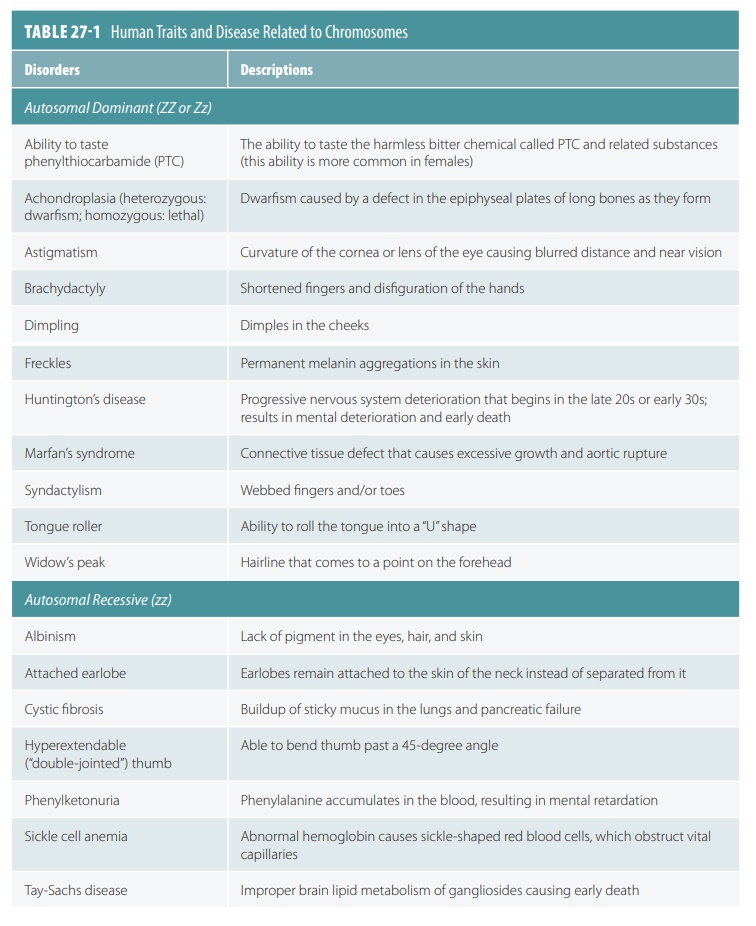
Incomplete Dominance
When incomplete
dominance occurs, a heterozy-gote has a phenotype that is
intermediate between the homozygous dominant and the homozygous
recessive. In this event, one allele variant masks the
other. The most well- known example is sickle cell anemia,
in which a sickling gene
or genes cause substitution
of one amino acid in the beta chain of hemoglobin. The molecules of hemoglobin
that con-tain abnormal beta chains crystallize when blood oxygen levels are
low. This causes the erythrocytes to assume a sickle shape. An individual who
has two sickling alleles (ss) has the condition. Anythingthat
lowers their blood oxygen level, such as exces-sive exercise or respiratory
problems, can lead to a sickle
cell crisis. The
deformed erythrocytes clump and fragment in small capillaries, resulting in
intense pain.
People who are heterozygous for the sickling gene (Ss) have sickle cell trait. Their bodies manufacture normal as
well as sickling hemoglobin. They are usu-ally healthy, but can suffer a sickle
cell crisis if their blood oxygen levels are reduced for a long time, such as
when traveling in high altitudes. These individuals may transmit the sickling
gene to their offspring.
Multiple Allele Inheritance
Some genes have more than two allele forms. This leads to multiple allele inheritance. While
three alleles determine human ABO blood types, every per-son receives two of
these. The alleles are:
■■ IA: Codominant, expressed when present, resulting in AB blood type
■■ IB: Also codominant, expressed when
present, resulting in AB blood type
■■ I: Recessive to the other type
alleles TABLE 27-2 explains
the effects of multiple allele inher-itance, using the examples of the ABO
blood groups.
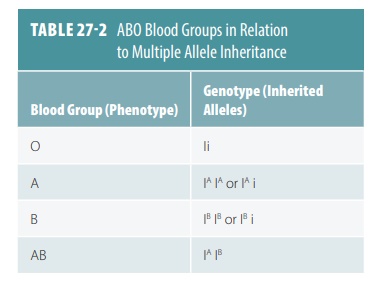
Sex-Linked Inheritance
Sex-linked
inheritance is determined by genes on the sex chromosome. The X and Y chromosomes are
not truly homologous. The Y chromosome contains the gene that determines the
male gender. It is much smaller than the X chromosome. The X chromosome has
over 1,400 genes, with most of them coding for proteins needed for brain
function. However, the Y chromosome only carries about 200 genes. It does not
have many of the genes that are present on the X chromosome, including genes
that code for some clotting factors, testosterone receptors, and cone
pig-ments. A gene that is only found on the X chromo-some is called X-linked. Relatively short areas
at the ends of the Y chromosome code for nonsexual char-acteristics that
correspond to those on the X chromo-some. These are the only areas that can
participate in crossovers with the X chromosome.
X- linked
recessive inheritance differs in how it affects
females and males. For a female, it is similar to autosomal recessive
inheritance because she has two X chromosomes—she can be a heterozygote or a
homozygote. Males, with only one X chromosome, express recessive alleles on
that chromosome, inheriting an X-linked recessive condition from a mother who
is a carrier or is affected. Examples are Duchenne’s muscular dystrophy, color blindness, and hemophilia. X- linked traits are usually passed from mother to son,
not father to son, since males receive no X chromosome from their fathers.
Moth-ers may also pass recessive alleles to their daugh-ters. However, unless
the daughter also receives a recessive allele from her father, the trait will
not be expressed.
Polygene Inheritance
Most phenotypes require several gene pairs at dif-ferent
locations, which act together. This polygene inheritance causes continuous,
quantitative various in phenotypes between two extremes. In polygene
inheritance, phenotypic characteristics are deter-mined by multiple alleles.
It explains a large amount of human characteristics, such as height,
intelligence, metabolic rate, and skin color. The color of your skin is
controlled by three or more separately inherited genes (FIGURE 27-4). Other examples of
polygene inheritance include obesity, cleft palate, diabetes mel-litus, autism,
baldness, hypertension, schizophrenia, and alcoholism.
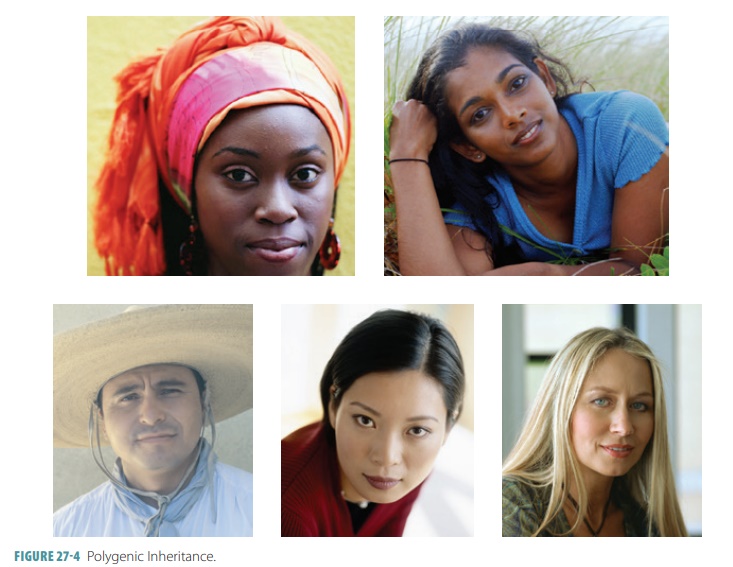
1. Explain the use of the Punnett square in calculating the
genotype and phenotype probabilities that may result from the union of two
heterozygous parents.
2. Give examples of common dominant and recessive traits.
3. Differentiate between the terms “sex-linked inheritance”
and “X-linked”.

